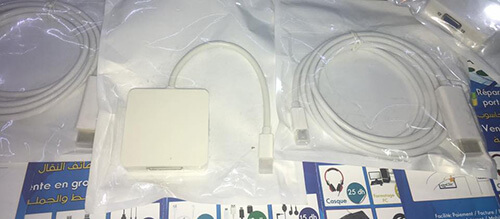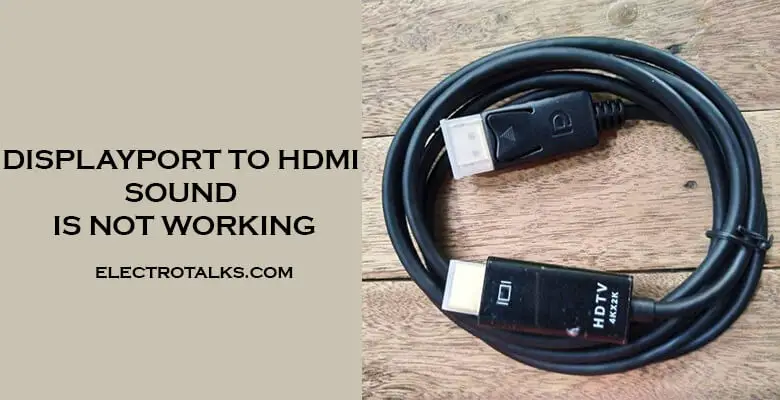“As an Amazon Associate, I earn from qualifying purchases. Without Any Extra Cost to You!”
Proper cable management and knowing which cable to use can always be a hassle. It can be due to the cable wasn’t labeled accurately or because of your device, you are unable to hear anything.
I, personally have faced this issue many times and had to run quite a few errands in finding a fix. I am guessing you are facing the same just as I did, and you are seeking answers.
You probably are not getting audio either from your adapter or from your display port to the HDMI cable. Worry not! As I am here to guide you over this issue with my many years of experience and research.
For your clarity: What are the Display Port and HDMI cable?
So, before everything, you need to have a thorough idea about which cable you are using. You could be confusing your Display port with an HDMI port or heck you could even own a completely different cable like a DVI or a VGA cable. Hence, let us talk about what are those two cables and their differences.
Display Port Cable
Among all the cables you can think of, DVI, VGA, or HDMI that we will talk about, Display Port is the latest and best out of all the cables out there. A display port is quite similar looking to an HDMI port. If you see that there’s only one side slanted in the port, then it is a Dp port.
A Dp port carries 20 pins, and there are two types of Display ports. One is for the more extensive devices, and the other is for smaller devices for Mac which is similar to Apple’s thunderbolt port.
But, our focus will be on the generic Display port cable. Display Port is able to transmit both audio and video at superior quality to HDMI cables.
HDMI Cable
Based on the most places I’ve seen and most devices I have used, HDMI cables and ports are the most common of all there have been. After HDMI 1.4, all of the cables were able to produce video and audio with their limitations.
It consists of 19 pins, and unlike the Display Port, the port of HDMI has both sides slanted. You will understand once you see one up front. There are in general, three types of HDMI cables.
We will focus on Type A as it is used on TV and monitor devices. Some of the latest HDMI cables can produce at a close bandwidth speed to a Display Port, but a DP port is still superior.
What should you go for, an adapter or a display port to HDMI cable?

Usually going for any one of the two is okay, but due to some technicalities. You may think that Display port to HDMI cables are not able to sound, but they actually just like any of those cables as single. My suggestion would be to always go for the sole DP to HDMI cable.
I mean, why take the hassle of attaching an extra adapter unless you see nothing is working. As for adapters, I don’t think there is any issue in getting one unless it is a passive adapter. Passive adapters have some form of lags because of having no semi-conductor, unlike the active adapter.
So, I would tell you to either get a Display Port to HDMI cable after gaining clarity over your devices or get the adapter but it has to be a passive one.
Why isn’t DisplayPort to HDMI sound not working
When you are going from Display port to HDMI, based on my understanding, you are evidently going to transmit video and audio from your PC to TV. And, this conversion either requires a Display port to HDMI cable or the adapter as we have talked about it above.
Now, your audio may not be produced due to a few reasons, some of which you are entirely unaware of, and some happened due to your technical changes in settings. So, let us go through the troubleshooting steps.
#The issue with your OS’s audio driver
This one might be a bit technical for you but bear with me. You’re probably using Windows 8 or 10, it could be 11 as well if you’re someone who likes to stay updated.
But, either way, it is your driver’s issue. Your driver isn’t able to detect the sound going to your TV. For that reason, you probably need to reinstall your audio driver.
Steps to Fix:
- Go to settings and then go to your device manager.
- Click on sound & audio.
- After that, a couple of sound drivers will pop based on the audio driver and graphics card you use. Left-click with your mouse to the High Definition Audio or your default and then uninstall it.
- Based on the processor you use, you now need to download your audio driver again. If you’re using a Windows 7, then here is the link to the latest driver.
- Download the latest driver. A zip file will open up and extract it to your desired location.
- Then go back to the device manager and go to sound & audio.
- Left-click on update driver. Windows will show two options available.
- One is Windows will recommend that they’ll search the latest driver automatically, and the other will be that you get it for them.
- You will browse it on your own and then click on next.
- Your windows will update it, and then you should be good to go.
These steps will look overwhelming to look at at first but trust me, once you have a read, then it will feel like a walk in the park.
#The issue with your Graphic Card’s Driver
Your windows audio driver can be related to your GPU’s driver. You could be using an Nvidia GPU or an AMD GPU. For this step, I can simply recommend you update your GPU’s driver.
It might be because you have been using a very old driver that hasn’t been updated in accordance with your PC specs. I suggest you update the drivers after you have updated the internal audio driver of your Pc. Now for Nvidia users, let us dive into it.
Steps to Fix:
- Go to Nvidia Geforce Experience.
- In the App, click on Drivers, which is beside Home.
- Then you will see an option to update.
- Update the driver, it’ll update not only the audio drivers but also the graphical elements as well.
Another thing, this one is a bit rare, but I have had a colleague face this. She was using an old HP laptop with an Nvidia graphics card, and it simply couldn’t generate any audio in the latest Nvidia driver.
So after multiple troubleshooting attempts, she was finally able to get sound after installing an older version of the Nvidia Geforce software. Hence, I recommend you try to install a couple of different drivers in case nothing is working.
#The issue with the cable or the adapter itself
This comes down as more of a suggestion, not as a solution, because if nothing else is working, then the issue comes within the manufacturer. Because I have seen people who have been using brands like HP and ViewSonic, they have struggled because of getting no audio through the Display Port to HDMI.
But instead, they used an adapter, and the audio was able to get transmitted. The change can also be the exact opposite because you could be owning a Passive adapter and your device may not support dual-mode DP++. DP++ helps in the conversion.
Frequently Asked Questions
Will using a VGA cable help instead of a Display port or HDMI?
No, it absolutely will not help because VGA cables are archaic now, and they merely produce a video that is not even of the highest quality. Whereas both DP and HDMI cables produce sound and video at the same time, and both of them can deliver the richest quality of audio and video together.
Is a DVI cable a good option to use instead of an adapter?
The answer actually lies down to if it can produce both audio and video at the same time. Because it can’t. A DVI cable can transmit video signal and it can only be a better alternative when it is in comparison with a VGA cable. In terms of video, DVI video can match up to the same refresh rate as the HDI cable.
Do we lose video quality in cable conversion?
With the latest cables, there is no loss of quality in using a Display Port to HDMI cable. However, you may experience a loss in quality for DVI or VGA conversions.
Will I get the same level of quality if I use a passive adapter?
Ans: No, you won’t because passive adapters don’t have semi-conductors. In the case of active adapters, there semi-conductors exist that help in the best possible quality. So, it is better to get an active adapter.
Wrap Up!
I fondly believe that you are now reasonably competent in regard to managing this issue. Handling various cables can be problematic in the beginning but after knowing things, doing the right thing isn’t exactly any problem at all.
And it goes for all types of people, even someone who is a complete novice with tech since technologies change and evolve pretty frequently, so I would recommend you to keep both the conversion cable and the adapter at the same time.
Because if you change your monitor or your tv then you also may need to use an adapter instead of the conversion cable or vice versa. Thus, I hope you will assist others as well regarding this issue because they deserve to have a wholesome TV experience just like you.

